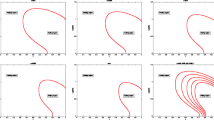Abstract
In this work, we study a right time for an investor to stop the investment among multi-assets over a given investment horizon so as to obtain maximum profit. We formulate it to a two-stage problem. The main problem is not a standard optimal stopping problem due to the non-adapted term in the objective function, and we turn it to a standard one by stochastic analysis. The subproblem with control variable in the drift and volatility terms is solved first via stochastic control method. A numerical example is presented to illustrate the efficiency of the theoretical results.

Similar content being viewed by others
References
Shiryaev, A., Xu, Z.Q., Zhou, X.Y.: Thou shalt buy and hold. Quant. Financ. 8, 765–776 (2008)
Du Toit, J., Peskir, G.: Selling a stock at the ultimate maximum. Ann. Appl. Probab. 19(3), 983–1014 (2009)
Dai, M., Zhong, Y.F.: Optimal stock selling/buying strategy with reference to the ultimate average. Math. Financ. 22(1), 165–184 (2012)
Markowitz, H.: Portfolio selection. J. Financ. 7(1), 77–91 (1952)
Markowitz, H.: Portfolio Selection: Efticient Diversification of Investments. Wiley, New York (1959)
Merton, R.C.: Lifetime portfolio selection under uncertainty: the continuous-time case. Rev. Econ. Stat. 51(3), 247–257 (1969)
Merton, R.C.: Optimum consumption and portfolio rules in a continuous-time model. J. Econ. Theory 3(4), 373–413 (1971)
Merton, R.C.: Theory of rational option pricing. Bell J. Econ. Manag. Sci. 4(1), 141–183 (1973)
Xu, G.L., Shreve, S.E.: A duality method for optimal consumption and investment under short-selling prohibition. I. General market coefficients. Ann. Appl. Probab. 2, 87–112 (1992)
Xu, G.L., Shreve, S.E.: A duality method for optimal consumption and investment under short-selling prohibition. II. Constant market coefficients. Ann. Appl. Probab. 2, 314–328 (1992)
Choi, K., Koo, H., Kwak, D.: Optimal stopping of active portfolio management. Ann. Econ. Financ. 5, 93–126 (2004)
Steele, J.M.: Stochastic Calculus and Financial Applications. Springer, Berlin (2012)
Karatzas, I., Shreve, S.E.: Methods of Mathematical Finance. Springer, New York (1998)
Peskir, G., Shiryaev, A.: Optimal Stopping and Free-Boundary Problems, 2nd edn. Birkhäuser Verlag, Berlin (2006)
Xu, G.L., Shreve, S.E.: A duality method for optimal consumption and investment under short-selling prohibition. II. Constant market coefficients. Ann. Appl. Probab. 2(2), 314–328 (1992)
Acknowledgements
We acknowledge the contribution of Professor Xun Li in the Hong Kong Polytechnic University for his valuable comments and suggestions to this paper.
Author information
Authors and Affiliations
Corresponding author
Additional information
This work is supported by the National Natural Science Foundation of China (Nos. 11571124 and 11671158), the doctoral start-up Grant of Natural Science Foundation of Guangdong Province, China (No. 2017A030310167), the Opening Project of Guangdong Province Key Laboratory of Computational Science at the Sun Yat-sen University (No. 201808) and Unversity of Macau (No. MYGR2018-00047-FST).
Appendices
Appendix
Expression of Function \(G_1\)
We now derive the explicit expression of the function \(G_1\), defined by
Note that
According to the standard normal distribution, we have
Assume that \(\nu \ne -\frac{1}{2}\). Then
Thus
In addition, note that when \(\nu = -\frac{1}{2}\),
Thus
Expression of Function \(G_2\)
We now derive the explicit expression of the function \(G_2\), defined by
Note that
According to the standard normal distribution, we have
Assume that \(\nu \ne -1\). Then
Thus
Also, note that when \(\nu = -1\),
Thus
Rights and permissions
About this article
Cite this article
Wu, XP., Vong, S. & Zhou, WX. Optimal Stopping Time of a Portfolio Selection Problem with Multi-assets. J. Oper. Res. Soc. China 9, 163–179 (2021). https://doi.org/10.1007/s40305-018-0223-5
Received:
Revised:
Accepted:
Published:
Issue Date:
DOI: https://doi.org/10.1007/s40305-018-0223-5




